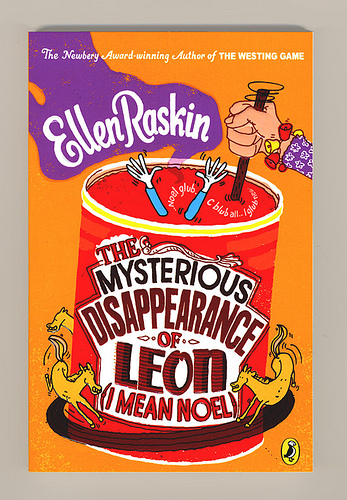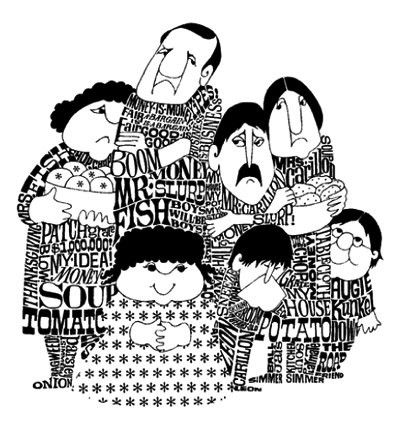
I’ve been re-reading a few favorite books from childhood and adolescence recently, trying to remember what made them so engaging and important to my younger self. Friends, I only wear three pairs of shoes, but I still own just about every book I cared about before my 18th birthday. (…not that I don’t still own all the ones that came after, too. I have a lot of books.)
Some are a delightful surprise, as I get to revisit everything I found wonderful about them as a kid while catching some of the more grown-up jokes and references – like suddenly realizing that funny skit from Sesame Street was a send-up of Saturday Night Live.
The Mysterious Disappearance of Leon (I Mean Noel) by Ellen Raskin is one of those. First published in 1971, it’s full of tongue-in-cheek period references (the grape workers strike, hippie art communes) that I blithely read past as a child. The lovely text-as-picture illustrations, which Ellen Raskin herself provided, are rendered in classic late sixties typography and line art.

The flip side of this is the effect the time period has on the plot. Much of the story hinges on the search for a missing person, and the techniques employed in that search are, while inherently ridiculous, also very much of their time. In the Facebook era, it’s almost easier to find acquaintances than it is to lose them.
I wondered for a moment how much this would mystify the children of today, but I dismissed the thought as patronizing. Once you’re old enough to read chapter books, much less mystery books with complicated word puzzles embedded within, you’re certainly old enough to understand that the facts of daily life were different in the past. How many dozens of books did I read as a child that were set or written in 19th century England? I wasn’t concerned by the presence of gas lamps and telegrams, so I don’t think a ten year-old in 2011 will be baffled by the presence of newspaper ads and black-and-white television.
The characters and tone are what really carry the book; as a kid, I enjoyed puzzles, but not at the expense of story. Characters are delightfully silly sketches – sweet, bumbling Mrs. Carillon, the no-nonsense orphan twins Tina and Tony, mishap-prone Augie Kunkel, plenty of screwball cameo characters, and the mysteriously disappearing Leon (or is it Noel?).
Puns, double-meanings, other languages, and slippery syllables run rampant throughout the book. Plot points include an underage wedding, an exploding soup factory, a falsely-incited riot at a department store, and a case of mistaken identity in the seal tank at the zoo (I realize the joke, decades later, that there are multiple references to literal red herrings! God bless you, Ellen). Certainly Daniel Handler read this book as a young person before adding his own dash of vinegar to the equation and coming up with the Lemony Snicket books.

My main disappointment with the book on re-reading was that I remembered the answer to the puzzle – and it’s a clever enough puzzle to challenge a grownup. Through her characters, Raskin does a lovely job showing how a person might go about solving it even without the authorial help of footnote hints. Nonetheless, the answer popped into my head the moment I read the first line – a testament to how many times I originally read the book.
I think that right there is enough to recommend the story. It’s a puzzle book, yes, but I was happy to read it again and again as a child, and to reread it now, in one sitting, as a grownup. It’s clever and sweet, briskly written and inventively illustrated.
It was just reprinted a few weeks ago, so please consider finding a copy for your favorite smart, inquisitive child aged 8-12. Or yourself! Ellen Raskin’s later and better-known puzzle classics, Figgs & Phantoms and The Westing Game, are widely available as well.